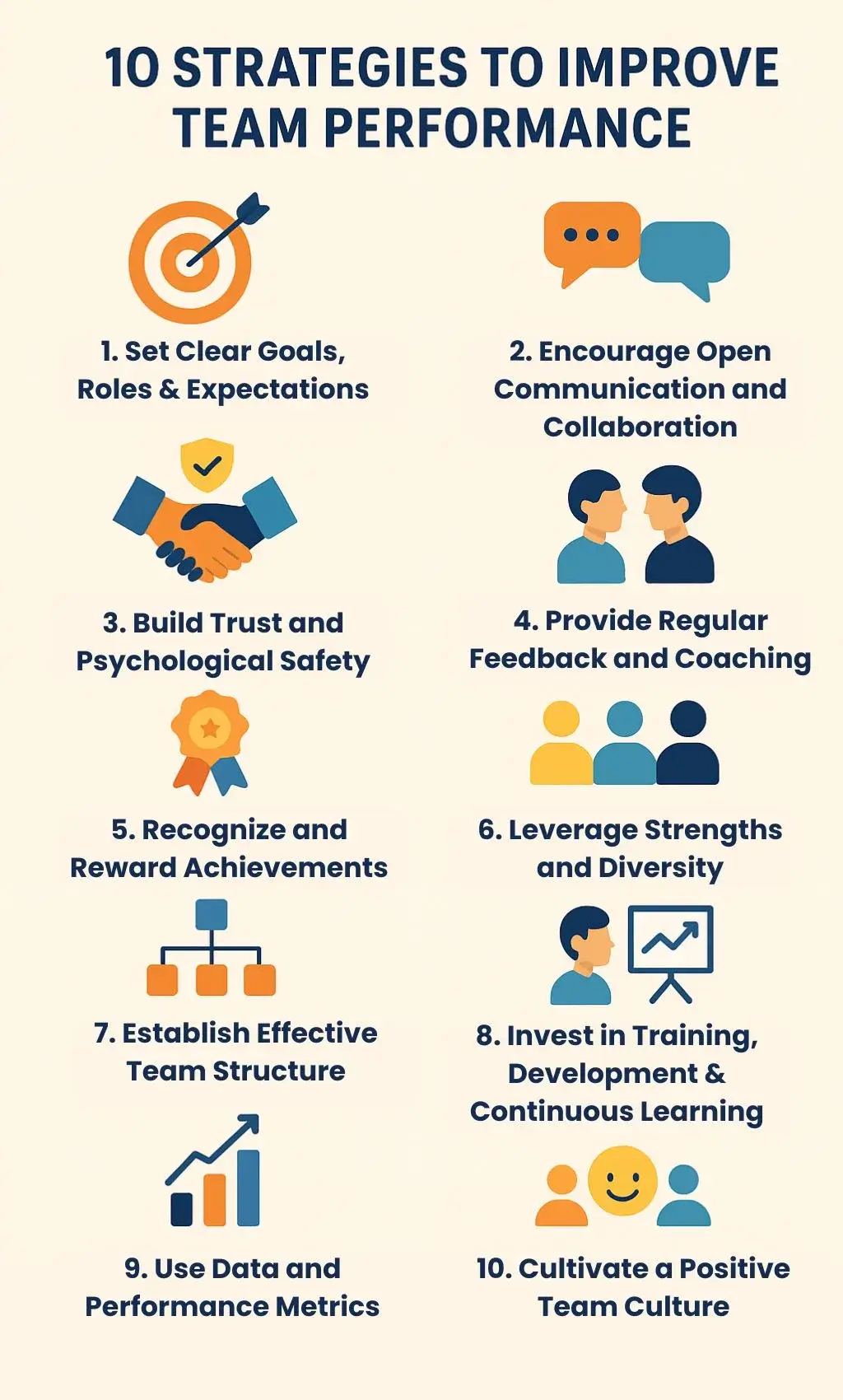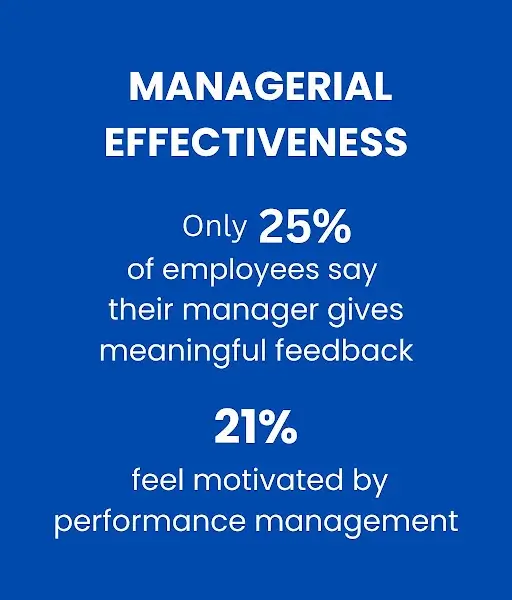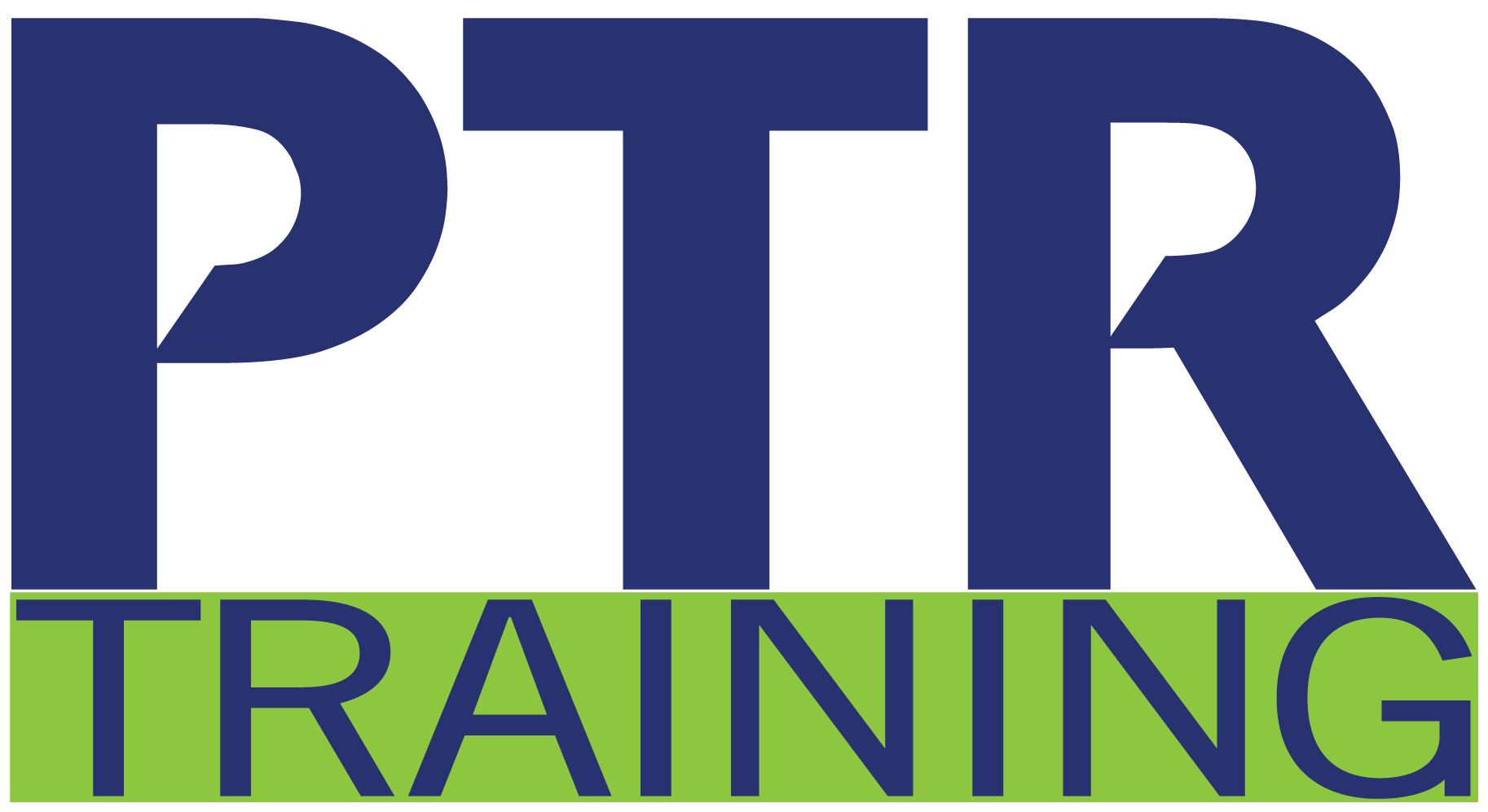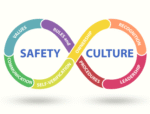
Improving team performance is essential for leaders and managers across industries. In fact, Gallup’s latest research found that top-quartile engaged teams are dramatically more productive and profitable – for example, highly engaged teams were 18% more productive in sales, 14% more productive in production, and 23% more profitable than low-engagement teams. Yet many teams struggle: one study found that about 85% of employees are not engaged or actively disengaged, while 75% of cross-functional teams underperform on key metrics. To boost performance, leaders need evidence-based strategies.
10 Strategies to Improve Team Performance
In today’s competitive business landscape, simply having talented individuals isn’t enough — it’s how effectively they work together that drives success. Research-backed strategies provide a clear roadmap for leaders to build stronger, more motivated, and higher-performing teams. By leveraging proven insights, organizations can not only boost productivity but also create a culture of collaboration, accountability, and continuous growth.

1. Set Clear Goals, Roles & Expectations
Clarity in purpose and roles is foundational. Teams perform better when they know what they need to do, when, and why. According to McKinsey, plotting team performance shows that the top 5-10% of teams consistently outperform the rest. One of the factors distinguishing them is disciplined kickoff meetings with clearly documented tasks and realistic due dates.
What this means in practice:
- Use SMART goals (Specific, Measurable, Achievable, Relevant, Time-bound).
- Define each team member’s role and responsibilities to avoid duplication or gaps.
- Review expectations periodically, especially when team composition or objectives change.
2. Encourage Open Communication and Collaboration
Open dialogue and collaboration are key to boosting team performance. Teams that communicate frequently and effectively solve problems faster and innovate more. Establish regular channels for sharing ideas – whether through team meetings, collaborative tools, or even informal check-ins. Agreeing on communication norms (for example, how quickly to respond to messages or how to run meetings) helps prevent misunderstandings.
Research shows that agreed-upon norms accelerate collaboration and streamline decision-making. For remote or hybrid teams, create a “team charter” that outlines communication protocols and expectations. In fact, Gallup reports that the most successful hybrid teams write their own game plan or charter for virtual work, which builds shared commitment and mutual responsibility.
Best Practices:
- Regular check-ins (daily standups, weekly reviews).
- Use tools and platforms that centralize communication (e.g., project management courses, shared dashboards).
- Share updates on progress, challenges, and successes.
Explore: Communication Training Courses
3. Build Trust and Psychological Safety
High-performing teams are built on trust and psychological safety. When team members feel safe to take risks, admit mistakes, and share candid feedback, creativity and problem-solving soar.
Google’s famed Project Aristotle confirmed that psychological safety is the most crucial factor in successful teams. Teams with high psychological safety generate more ideas, drive more revenue, and are rated “effective” twice as often by executives as teams lacking safety.
McKinsey similarly found that teams above-average in trust were 3.3 times more efficient and 5.1 times more likely to deliver results than low-trust teams. To foster this environment, leaders should encourage transparency, admit their own mistakes, and create a no-blame culture.
Tips for fostering safety:
Model vulnerability, invite input from all levels, and explicitly reinforce that all ideas and concerns are welcome. Over time, this builds a culture where team members confidently support one another, which directly translates into higher performance.
4. Provide Regular Feedback and Coaching
Ongoing feedback and coaching fuel continuous improvement. Unfortunately, many managers underinvest in this area: Gallup found that only about 25% of employees strongly agree that their manager provides meaningful feedback. Only 21% feel their performance is managed in a motivating way. Strong evidence shows that managers are the single most significant factor in team engagement – accounting for roughly 70% of the variance between teams.

The best managers act as coaches, holding frequent one-on-ones and performance conversations tailored to each person’s needs. These ongoing dialogues ensure that roadblocks are identified early and employees stay aligned with goals.
What this involves:
- Frequent check-ins, one-on-one meetings.
- Mid-project reviews, not waiting until the end.
- Using tools and dashboards to track KPIs.
- Ensuring fairness, transparency, and clarity in feedback.
5. Recognize and Reward Achievements
Recognition isn’t just “nice to have”; it influences productivity, engagement, and performance. According to the WifiTalents statistics report, employees whose managers focus on strengths are around 7.8% more productive. High performers often set personal development goals and are more motivated when their efforts are acknowledged.
Ways to reward and recognize:
- Public praise in meetings.
- Performance bonuses or small non-monetary rewards.
- Career development opportunities.
- Celebrations of team milestones.
6. Leverage Strengths and Diversity
Maximizing performance means playing to each team member’s strengths and embracing diverse perspectives. Gallup found that strengths-based development yields measurable gains: organizations that focus on strengths see 8–18% performance improvements and higher profitability. Encouraging people to use what they do best raises individual engagement by up to 15% and drives the whole team’s results. At the same time, teams with diverse skills and backgrounds solve problems more effectively. McKinsey’s research on team health shows that having a mix of perspectives is a critical driver of performance. When diverse viewpoints are included, teams innovate and adapt faster.
Actionable steps:
Use strengths assessments to identify and assign roles that match each person’s natural talents. In meetings, explicitly solicit input from team members with different expertise. Foster an inclusive culture where all voices are heard.
By empowering members to contribute their unique strengths, you not only motivate individuals but also improve overall team performance.
7. Establish Effective Team Structure
Well-defined team structures and processes eliminate confusion and friction. Role clarity is crucial – every member should know their responsibilities and decision-making boundaries.
McKinsey highlights “role definition” as a key driver of team health: effective teams ensure that each person understands their expectations. Similarly, defining transparent decision-making processes prevents delays. Teams above-average in decision-making were found to be 2.8 times more innovative than below-average teams.
Another factor is optimal team size: Gallup notes that small teams (4–6 people) often collaborate more effectively, unless a manager is exceptionally talented.
8. Invest in Training, Development & Continuous Learning
Continuous learning keeps teams sharp and innovative. High-performing teams invest in skill-building and career growth. A solid performance management approach will identify skill gaps and then offer targeted training or mentorship to fill them. This not only improves current performance (by better equipping team members) but also signals that the organization values their development. Research shows training improves morale and productivity, leading employees to produce better results. For example, PTR has famously boosted performance and engagement through regular skill courses and leadership and management training courses.
What to do:
- Identify skill gaps via assessments or feedback.
- Offer workshops, certifications, and cross-training.
- Encourage peer learning and mentorship.
9. Use Data and Performance Metrics
What gets measured gets managed. Implementing a continuous performance management system keeps teams on track. Define Key Performance Indicators (KPIs) and milestones that align with your goals. KPIs are essential for tracking progress and help gauge whether individuals and teams are meeting expectations.
Key metrics to consider:
- Task completion rate/deadline adherence
- Quality defect rates
- Cycle times (how long tasks take)
- Collaboration or communication effectiveness (via surveys)
- Employee satisfaction and engagement scores
Learn with us: Data Analytics Training
10. Cultivate a Positive Team Culture
Finally, nurture a work environment where people want to excel. A supportive, inclusive culture boosts morale and engagement, which in turn lifts performance. Ensure the team’s values are clearly stated and consistently reinforced.
Gallup research shows that a strong culture of learning and appreciation helps retain high performers. For remote or hybrid teams, explicitly address well-being and flexibility. For instance, Google’s studies found that teams with hybrid-work charters – jointly developed rules on when to meet in person versus online – experienced higher commitment and ownership. Encourage work-life balance and recognize that personal well-being impacts productivity.
Implementation tips:
Define team norms collectively. Invest in team-building activities to strengthen bonds. Survey the team periodically for feedback on the culture and act on it. A positive culture doesn’t just feel good – it makes the team more resilient and focused.
As one guide explains, monitoring engagement and addressing concerns “keeps your team from hitting roadblocks… The outcome? A workplace culture that fosters growth and success”.
Why These Strategies Work
Putting these strategies together addresses both the structural and human side of performance:
- Structural like goals, roles, metrics, systems, processes.
- Human side, like trust, psychological safety, recognition, and well-being.
Statistics show that teams that score high in teamwork quality, norm clarity, and psychological safety deliver significantly better outcomes.
Similarly, teams that track metrics and use data are more likely to see measurable progress (productivity, profitability) as seen in multiple studies and reports.
Conclusion and Takeaways
Improving team performance isn’t magic – it’s the result of intentional leadership and evidence-based practices. By setting clear goals, communicating openly, building trust, and providing feedback, you establish the foundation for high performance. Further, recognizing achievements, leveraging strengths, clarifying roles, investing in skills, tracking progress, and nurturing culture each multiply your impact.
Remember these key points:
- Define and align goals. Ensure every team member understands the purpose and their role.
- Communicate and collaborate. Create safe spaces for idea-sharing and clearly agreed processes.
- Coach and recognize. Give regular feedback, praise efforts, and reward successes promptly.
- Measure and adapt. Use data to guide decisions and continuously refine your approach.
By applying these strategies – backed by research and real-world examples – leaders and HR professionals can boost team performance and unleash their team’s full potential. With focus, persistence, and the right tools, you’ll see your team become more engaged, productive, and innovative..
Looking to transform your team’s performance? Explore our leadership and professional development training courses designed to unlock potential and drive results.
FAQs
1. What does improving team performance mean?
Improving team performance means enhancing how effectively a team works together to achieve shared goals. It involves increasing productivity, communication, collaboration, and accountability among team members.
2. Why is team performance necessary for business success?
Team performance plays a vital role in driving productivity, innovation, and employee satisfaction. When teams work efficiently and collaborate effectively, they help organizations achieve goals faster, deliver higher-quality results, and maintain a positive workplace culture.
3. What are the strategies to improve team performance?
The most effective strategies include setting clear goals, promoting open communication, building trust, offering regular feedback, recognizing achievements, and fostering a positive team culture.
4. How can leaders boost team performance effectively?
Leaders can boost performance by clearly defining expectations, providing consistent coaching, leveraging team strengths, and using performance metrics to track progress and improvements.
5. How does trust influence team performance?
Trust creates an environment where team members feel confident sharing ideas, taking initiative, and solving challenges together. When trust is strong, communication improves, collaboration increases, and the entire team becomes more cohesive and effective.
6. How often should team performance be reviewed?
Ideally, team performance should be reviewed monthly or quarterly. Regular check-ins ensure teams stay aligned with goals, adapt to changes quickly, and maintain consistent progress.










